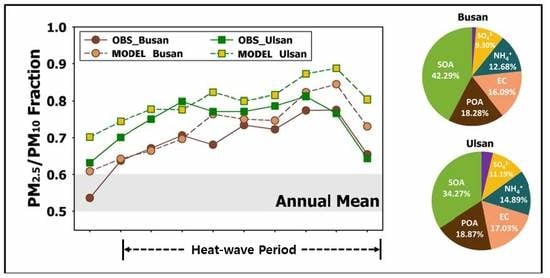Numerical Sensitivity Tests of Volatile Organic Compounds Emission to PM2.5 Formation during Heat Wave Period in 2018 in Two Southeast Korean Cities
Abstract
1. Introduction
2. Study Area and Geographic Features
3. Model, Input Data, and Simulation Experiments
4. Case Description
5. Sensitivity Simulations of VOC Emission and SOA Generation
6. Results and Discussion
7. Summary
Author Contributions
Funding
Acknowledgments
Conflicts of Interest
References
- Saliba, N.A.; Kouyoumdjian, H.; Roumie, M. Effect of local and long-range transport emissions on the elemental composition of PM10–2.5 and PM2.5 in Beirut. Atmos. Environ. 2007, 41, 6497–6509. [Google Scholar] [CrossRef]
- Squizzato, S.; Masiol, M.; Innocente, E.; Pecorari, E.; Rampazzo, G.; Pavoni, B. A procedure to assess local and long-range transport contributions to PM2.5 and secondary inorganic aerosol. J. Aerosol Sci. 2012, 46, 64–76. [Google Scholar] [CrossRef]
- Wang, L.; Liu, Z.; Sun, Y.; Ji, D.; Wang, Y. Long-range transport and regional sources of PM2.5 in Beijing based on long-term observations from 2005 to 2010. Atmos. Res. 2015, 157, 37–48. [Google Scholar] [CrossRef]
- Sun, Y.; Zhuang, G.; Tang, A.; Wang, Y.; An, Z. Chemical characteristics of PM2.5 and PM10 in haze−fog episodes in Beijing. Environ. Sci. Technol. 2006, 40, 3148–3155. [Google Scholar] [CrossRef]
- Zhao, X.J.; Zhao, P.S.; Xu, J.; Meng, W.; Pu, W.W.; Dong, F.; He, D.; Shi, Q.F. Analysis of a winter regional haze event and its formation mechanism in the North China Plain. Atmos. Chem. Phys. 2013, 13, 5685–5696. [Google Scholar] [CrossRef]
- Wakamatsu, S.; Uno, I.; Suzuki, M. A field study of photochemical smog formation under stagnant meteorological conditions. Atmos. Environ. Part A Gen. Top. 1990, 24, 1037–1050. [Google Scholar] [CrossRef]
- Tai, A.P.; Mickley, L.J.; Jacob, D.J. Correlations between fine particulate matter (PM2.5) and meteorological variables in the United States: Implications for the sensitivity of PM2.5 to climate change. Atmos. Environ. 2010, 44, 3976–3984. [Google Scholar] [CrossRef]
- Wang, D.; Zhou, B.; Fu, Q.; Zhao, Q.; Zhang, Q.; Chen, J.; Yang, X.; Duan, Y.; Li, J. Intense secondary aerosol formation due to strong atmospheric photochemical reactions in summer: Observations at a rural site in eastern Yangtze River Delta of China. Sci. Total Environ. 2016, 571, 1454–1466. [Google Scholar] [CrossRef]
- Sun, J.; Gong, J.; Zhou, J.; Liu, J.; Liang, J. Analysis of PM2.5 pollution episodes in Beijing from 2014 to 2017: Classification, interannual variations and associations with meteorological features. Atmos. Environ. 2019, 213, 384–394. [Google Scholar] [CrossRef]
- KMA (Korea Meteorological Administration). Press Release. 2018. Available online: http://www.kma.go.kr/notify/press/kma_list.jsp?bid=press&mode=view&num=1193585 (accessed on 17 August 2018).
- NIER (National Institute of Environmental Research). Annual Report of Air Quality in Korea, 2018; NIER: Incheon, Korea, 2019.
- Haagen-Smit, A.J. Chemistry and physiology of Los Angeles smog. Ind. Eng. Chem. 1952, 44, 1342–1346. [Google Scholar] [CrossRef]
- Filella, I.; Penuelas, J. Daily, weekly and seasonal relationships among VOCs, NOx x and O3 in a semi-urban area near Barcelona. J. Atmos. Chem. 2006, 54, 189–201. [Google Scholar] [CrossRef]
- Wang, Q.G.; Han, Z.; Wang, T.; Zhang, R. Impacts of biogenic emissions of VOC and NOx on tropospheric ozone during summertime in eastern China. Sci. Total Environ. 2008, 395, 41–49. [Google Scholar] [CrossRef] [PubMed]
- Duncan, B.N.; Yoshida, Y.; Olson, J.R.; Sillman, S.; Martin, R.V.; Lamsal, L.; Hu, Y.; Pickering, K.E.; Retscher, C.; Allen, D.J.; et al. Application of OMI observations to a space-based indicator of NOx and VOC controls on surface ozone formation. Atmos. Environ. 2010, 44, 2213–2223. [Google Scholar] [CrossRef]
- Tan, Z.; Lu, K.; Jiang, M.; Su, R.; Dong, H.; Zeng, L.; Zhang, Y. Exploring ozone pollution in Chengdu, southwestern China: A case study from radical chemistry to O3-VOC-NOx sensitivity. Sci. Total Environ. 2018, 636, 775–786. [Google Scholar] [CrossRef] [PubMed]
- Guenther, A.B.; Monson, R.K.; Fall, R. Isoprene and monoterpene emission rate variability: Observations with eucalyptus and emission rate algorithm development. J. Geophys. Res. Atmos. 1991, 96, 10799–10808. [Google Scholar] [CrossRef]
- Guenther, A.B.; Zimmerman, P.R.; Harley, P.C.; Monson, R.K.; Fall, R. Isoprene and monoterpene emission rate variability: Model evaluations and sensitivity analyses. J. Geophys. Res. Atmos. 1993, 98, 12609–12617. [Google Scholar] [CrossRef]
- Geron, C.; Guenther, A.; Greenberg, J.; Loescher, H.W.; Clark, D.; Baker, B. Biogenic volatile organic compound emissions from a lowland tropical wet forest in Costa Rica. Atmos. Environ. 2002, 36, 3793–3802. [Google Scholar] [CrossRef]
- Geron, C.; Guenther, A.; Greenberg, J.; Karl, T.; Rasmussen, R. Biogenic volatile organic compound emissions from desert vegetation of the Southwestern US. Atmos. Environ. 2006, 40, 1645–1660. [Google Scholar] [CrossRef]
- Churkina, G.; Kuik, F.; Bonn, B.; Lauer, A.; Grote, R.; Tomiak, K.; Butler, T.M. Effect of VOC Emissions from Vegetation on Air Quality in Berlin during a Heatwave. Environ. Sci. Technol. 2017, 51, 6120–6130. [Google Scholar] [CrossRef]
- Tunved, P.; Hansson, H.-C.; Kerminen, V.-M.; Ström, J.; Dal Maso, M.; Lihavainen, H.; Viisanen, Y.; Aalto, P.P.; Komppula, M.; Kulmala, M. High Natural Aerosol Loading over Boreal Forests. Science 2006, 312, 261–263. [Google Scholar] [CrossRef]
- Hodzic, A.; Jimenez, J.L.; Madronich, S.; Aiken, A.C.; Bessagnet, B.; Curci, G.; Fast, J.; Lamarque, J.-F.; Onasch, T.B.; Roux, G.; et al. Modeling organic aerosols during MILAGRO: Importance of biogenic secondary organic aerosols. Atmos. Chem. Phys. 2009, 9, 6949–6981. [Google Scholar] [CrossRef]
- Chen, Q.; Farmer, D.K.; Schneider, J.; Zorn, S.R.; Heald, C.L.; Karl, T.G.; Guenther, A.; Allan, J.D.; Robinson, N.; Coe, H.; et al. Mass Spectral Characterization of Submicron Biogenic Organic Particles in the Amazon Basin. Geophys. Res. Lett. 2009, 36, L20806. [Google Scholar] [CrossRef]
- Slowik, J.G.; Stroud, C.; Bottenheim, J.W.; Brickell, P.C.; Chang, R.Y.-W.; Liggio, J.; Makar, P.A.; Martin, R.V.; Moran, M.D.; Shantz, N.C.; et al. Characterization of a large biogenic secondary organic aerosol event from eastern Canadian forests. Atmos. Chem. Phys. 2010, 10, 2825–2845. [Google Scholar] [CrossRef]
- Nault, B.A.; Campuzano-Jost, P.; Day, D.A.; Schroder, J.C.; Anderson, B.; Beyersdorf, A.J.; Blake, D.R.; Brune, W.H.; Choi, Y.; Corr, C.A.; et al. Secondary organic aerosol production from local emissions dominates the organic aerosol budget over Seoul, South Korea, during KORUS-AQ. Atmos. Chem. Phys. 2018, 18, 17769–17800. [Google Scholar] [CrossRef]
- Heald, P.C.; Schladow, S.G.; Allen, B.C.; Reuter, J.E. VOC Loading from Marine Engines to a Multiple–use Lake. Lake Reserv. Manag. 2005, 21, 30–38. [Google Scholar] [CrossRef]
- De Gouw, J.A.; Middlebrook, A.M.; Warneke, C.; Goldan, P.D.; Kuster, W.C.; Roberts, J.M.; Fehsenfeld, F.C.; Worsnop, D.R.; Canagaratna, M.R.; Pszenny, A.A.; et al. Budget of organic carbon in a polluted atmosphere: Results from the New England Air Quality Study in 2002. J. Geophys. Res. Atmos. 2005, 110. [Google Scholar] [CrossRef]
- Volkamer, R.; Jimenez, J.L.; Martini, F.S.; Dzepina, K.; Zhang, Q.; Salcedo, D.; Molina, L.T.; Worsnop, D.R.; Molina, M.J. Secondary organic aerosol formation from anthropogenic air pollution: Rapid and higher than expected. Geophys. Res. Lett. 2006, 33, L17811. [Google Scholar] [CrossRef]
- Pun, B.K.; Seigneur, C. Investigative modeling of new pathways for secondary organic aerosol formation. Atmos. Chem. Phys. 2007, 7, 2199–2216. [Google Scholar] [CrossRef]
- Simpson, D.; Yttri, K.E.; Klimont, Z.; Kupiainen, K.; Caseiro, A.; Gelencsér, A.; Pio, C.; Puxbaum, H.; Legrand, M. Modeling carbonaceous aerosol over Europe: Analysis of the CARBOSOL and EMEP EC/OC Campaigns. J. Geophys. Res. Atmos. 2007, 112, D23S14. [Google Scholar] [CrossRef]
- Hodzic, A.; Jimenez, J.L.; Madronich, S.; Canagaratna, M.R.; DeCarlo, P.F.; Kleinman, L.; Fast, J. Modeling organic aerosols in a megacity: Potential contribution of semi-volatile and intermediate volatility primary organic compounds to secondary organic aerosol formation. Atmos. Chem. Phys. 2010, 10, 5491–5514. [Google Scholar] [CrossRef]
- Tsimpidi, A.P.; Karydis, V.A.; Zavala, M.; Lei, W.; Molina, L.; Ulbrich, I.M.; Jimenez, J.L.; Pandis, S.N. Evaluation of the volatility basis-set approach for the simulation of organic aerosol formation in the Mexico City metropolitan area. Atmos. Chem. Phys. 2010, 10, 525–546. [Google Scholar] [CrossRef]
- Rubin, J.I.; Kean, A.J.; Harley, R.A.; Millet, D.B.; Goldstein, A.H. Temperature dependence of volatile organic compound evaporative emissions from motor vehicles. J. Geophys. Res. Atmos. 2006, 111. [Google Scholar] [CrossRef]
- Faber, J.; Brodzik, K.; Łomankiewicz, D.; Gołda-Kopek, A.; Nowak, J.; Świątek, A. Temperature influence on air quality inside cabin of conditioned car. Combust. Engines 2012, 149, 49–56. [Google Scholar]
- Jacob, D.J.; Winner, D.A. Effect of Climate Change on Air Quality. Atmos. Environ. 2009, 43, 51–63. [Google Scholar] [CrossRef]
- Svendby, T.M.; Lazaridis, M.; Torseth, K. Temperature dependent secondary organic aerosol formation from terpenes and aromatics. J. Atmos. Chem. 2008, 59, 25–46. [Google Scholar] [CrossRef]
- Takekawa, H.; Minoura, H.; Yamazaki, S. Temperature dependence of Secondary Organic Aerosol formation by Photo-oxidation of hydrocarbons. Atmos. Environ. 2003, 37, 3413–3424. [Google Scholar] [CrossRef]
- Sheehan, P.E.; Bowman, F.M. Estimated effects of temperature on secondary organic aerosol concentrations. Environ. Sci. Technol. 2001, 35, 2129–2135. [Google Scholar] [CrossRef]
- Shon, Z.-H. Emissions of Ozone Precursors from a Biogenic Source and Port-related Sources in the Largest Port City of Busan, Korea. Asian J. Atmos. Environ. 2015, 9, 39–47. [Google Scholar] [CrossRef]
- Guenther, A.; Karl, T.; Harley, P.; Wiedinmyer, C.; Palmer, P.I.; Geron, C. Estimates of global terrestrial isoprene emissions using MEGAN (Model of Emissions of Gases and Aerosols from Nature). Atmos. Chem. Phys. 2006, 6, 3181–3210. [Google Scholar] [CrossRef]
- BMC (Busan Metropolitan City). 55th Busan Statistical Yearbook; BMC: Busan, Korea, 2017. [Google Scholar]
- MOE (Ministry of Environment). Environmental Statistics Yearbook; MOE: Seoul, Korea, 2018.
- UMC (Ulsan Metropolitan City). Statistical Yearbook; UMC: Ulsan, Korea, 2016. [Google Scholar]
- Oh, I.-B.; Kim, Y.-K. Surface Ozone in The Major Cities of Korea: Trends, Diurnal and Seasonal Variations, and Horizontal Distributions. J. Korean Soc. Atmos. Environ. 2002, 18, 253–264. [Google Scholar]
- Skamarock, W.C.; Klemp, J.B.; Dudhia, J.; Gill, D.O.; Barker, D.M.; Wang, W.; Powers, J.G. A Description of the Advanced Research WRF Version 3, NCAR/TN–475+STR NCAR TECHNICAL NOTE; Mesoscale and Microscale Meteorology Division, National Center of Atmospheric Research: University Park, PA, USA, 2008. [Google Scholar]
- Grell, G.A.; Peckham, S.E.; Schmitz, R.; McKeen, S.A.; Frost, G.; Skamarock, W.C.; Eder, B. Fully coupled “online” chemistry within the WRF model. Atmos. Environ. 2005, 39, 6957–6975. [Google Scholar] [CrossRef]
- Fast, J.D.; Gustafson, W.I., Jr.; Easter, R.C.; Zaveri, R.A.; Barnard, J.C.; Chapman, E.G.; Grell, G.A. Evolution of ozone, particulates, and aerosol direct forcing in an urban area using a new fully coupled meteorology, chemistry, and aerosol model. J. Geophys. Res. 2006, 111, D21305. [Google Scholar] [CrossRef]
- Multi-resolution Emission Inventory of China (MEIC). Available online: http://www.meicmodel.org/ (accessed on 27 January 2020).
- Clean Air Policy Support System (CAPSS). Available online: http://airemiss.nier.go.kr (accessed on 27 January 2020).
- Regional Emission Inventory in Asia (REAS) Version 2. Available online: http://www.jamstec.go.jp/frsgc/research/d4/emission.htm (accessed on 27 January 2020).
- Goldberg, D.L.; Saide, P.E.; Lamsal, L.N.; de Foy, B.; Lu, Z.; Woo, J.H.; Streets, D.G. A top-down assessment using OMI NO2 suggests an underestimate in the NOx emissions inventory in Seoul, South Korea, during KORUS-AQ. Atmos. Chem. Phys. 2019, 19, 1801–1818. [Google Scholar] [CrossRef]
- Miyazaki, K.; Eskes, H.J.; Sudo, K. Global NOx emission estimates derived from an assimilation of OMI tropospheric NO2 columns. Atmos. Chem. Phys. 2012, 12, 2263. [Google Scholar] [CrossRef]
- Wu, X.; Huang, W.; Zhang, Y.; Zheng, C.; Jiang, X.; Gao, X.; Cen, K. Characteristics and uncertainty of industrial VOCs emissions in China. Aerosol Air Qual. Res. 2015, 15, 1045–1058. [Google Scholar] [CrossRef]
- Kim, C.-H.; Park, S.-U.; Song, C.-K. A simple semi-empirical photochemical model for the simulation of ozone concentration in the Seoul metropolitan area in Korea. Atmos. Environ. 2005, 39, 5597–5607. [Google Scholar] [CrossRef]
- Kim, C.-H.; Kim, Y.-K.; Lee, H.W.; Seo, K.-H. A simple method for simulating horizontal ozone concentration fields over coastal areas: A case study of the Seoul metropolitan area, Korea. Terr. Atmos. Ocean. Sci. 2009, 20, 355–363. [Google Scholar] [CrossRef][Green Version]
- Kanakidou, M.; Seinfeld, J.H.; Pandis, S.N.; Barnes, I.; Dentener, F.J.; Facchini, M.C.; Van Dingenen, R.; Ervens, B.; Nenes, A.; Nielsen, C.J.; et al. Organic aerosol and global climate modelling: A review. Atmos. Chem. Phys. 2005, 5, 1053–1123. [Google Scholar] [CrossRef]
- Hallquist, M.; Wenger, J.C.; Baltensperger, U.; Rudich, Y.; Simpson, D.; Claeys, M.; Dommen, J.; Donahue, N.M.; George, C.; Goldstein, A.H.; et al. The formation, properties and impact of secondary organic aerosol: Current and emerging issues. Atmos. Chem. Phys. 2009, 9, 5155–5236. [Google Scholar] [CrossRef]
- Emery, C.; Liu, Z.; Russell, A.G.; Odman, M.T.; Yarwood, G.; Kumar, N. Recommendations on statistics and benchmarks to assess photochemical model performance. J. Air Waste Manag. Assoc. 2016, 67, 582–598. [Google Scholar] [CrossRef]
- Sugimoto, N.; Shimizu, A.; Matsui, I.; Nishikawa, M. A method for estimating the fraction of mineral dust in particulate matter using PM2.5-to-PM10 ratios. Particuology 2016, 28, 114–120. [Google Scholar] [CrossRef]
- Xu, G.; Jiao, L.; Zhang, B.; Zhao, S.; Yuan, M.; Gu, Y.; Liu, J.; Tang, X. Spatial and Temporal Variability of the PM2.5/PM10 Ratio in Wuhan, Central China. Aerosol Air Qual. Res. 2017, 17, 741–751. [Google Scholar] [CrossRef]
- BRI (Busan Research Institute). Annual Report of Air Pollution and Environment in Busan Metropolitan Area; BRI: Busan, Korea, 2019. [Google Scholar]
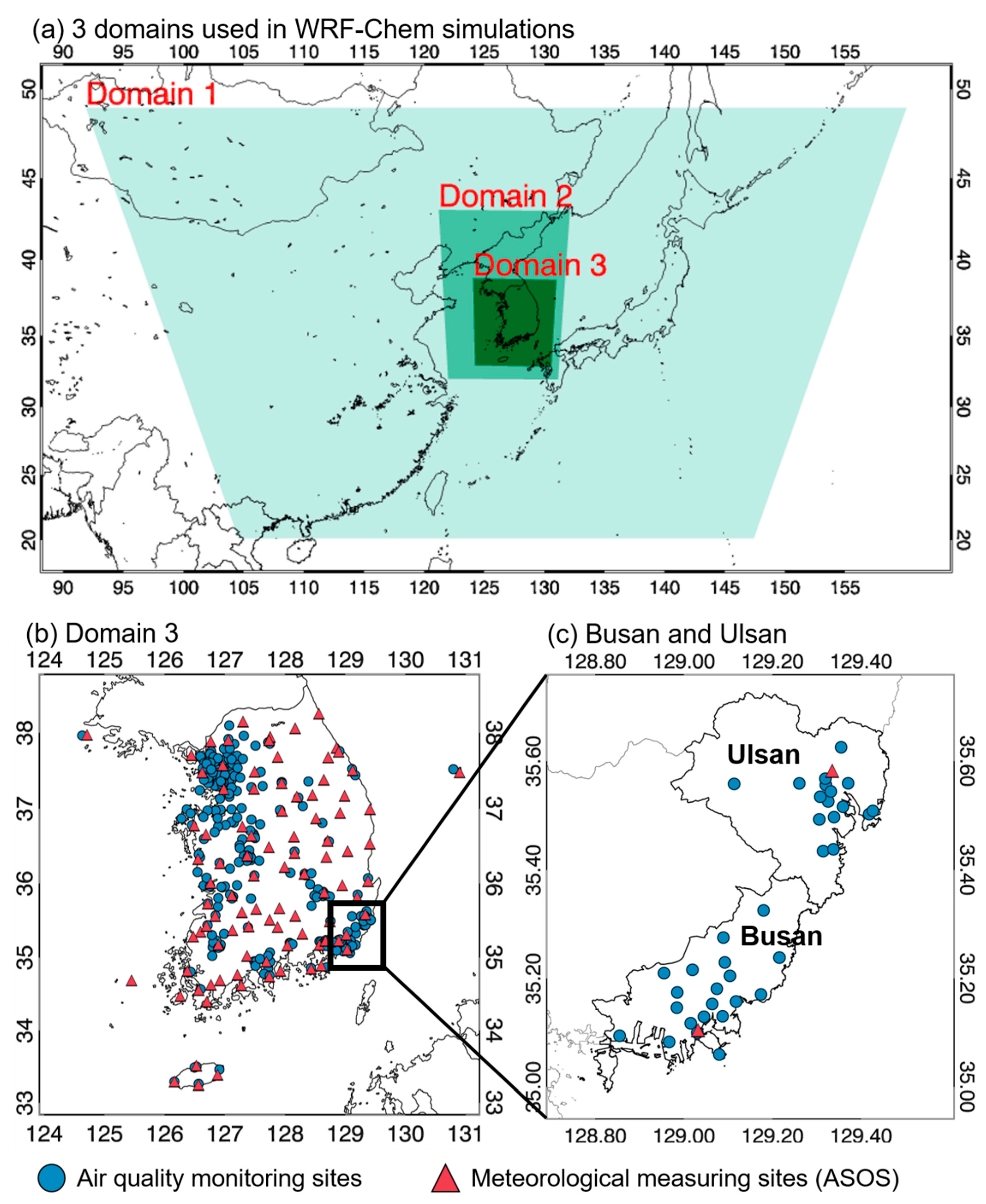
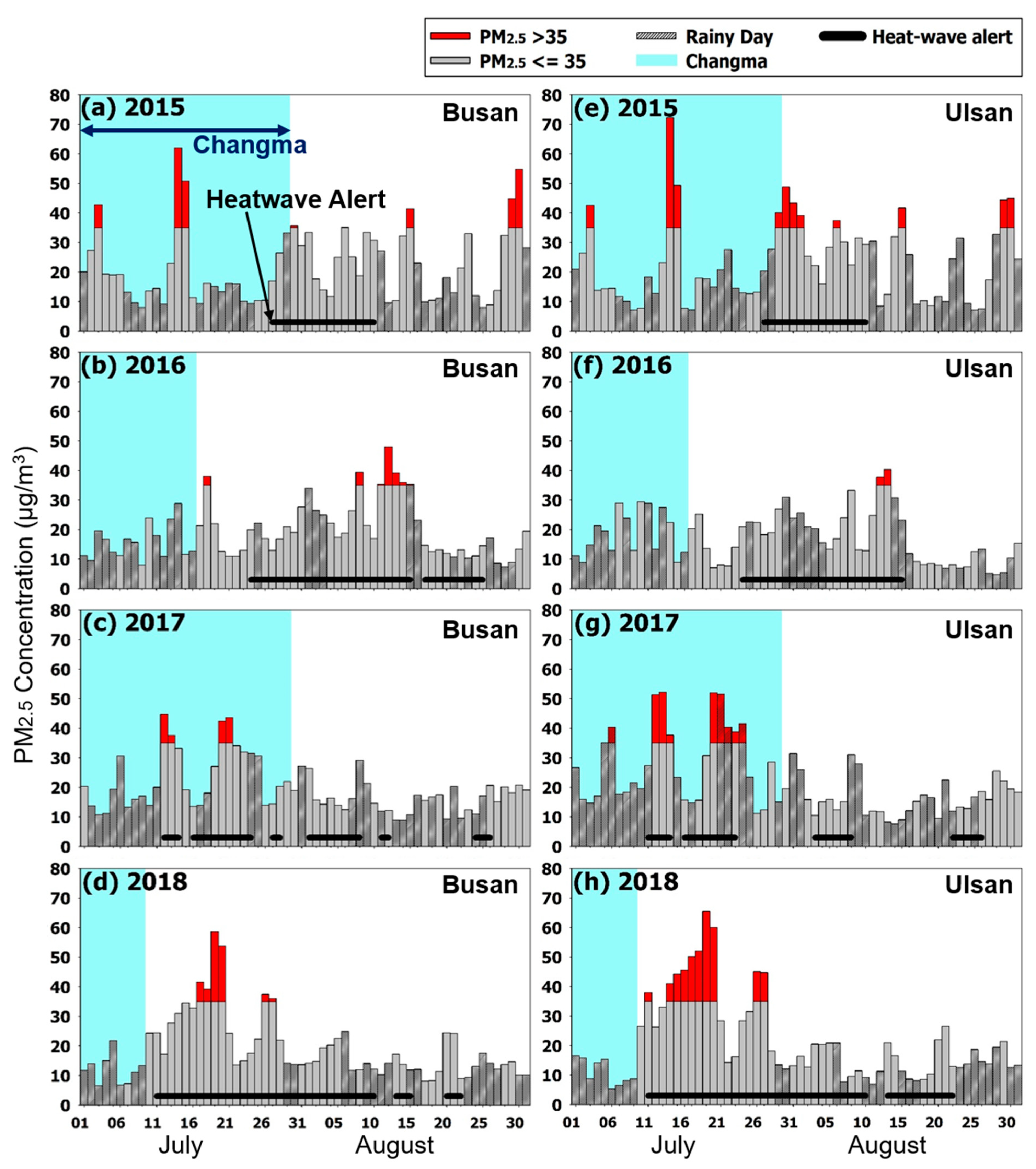
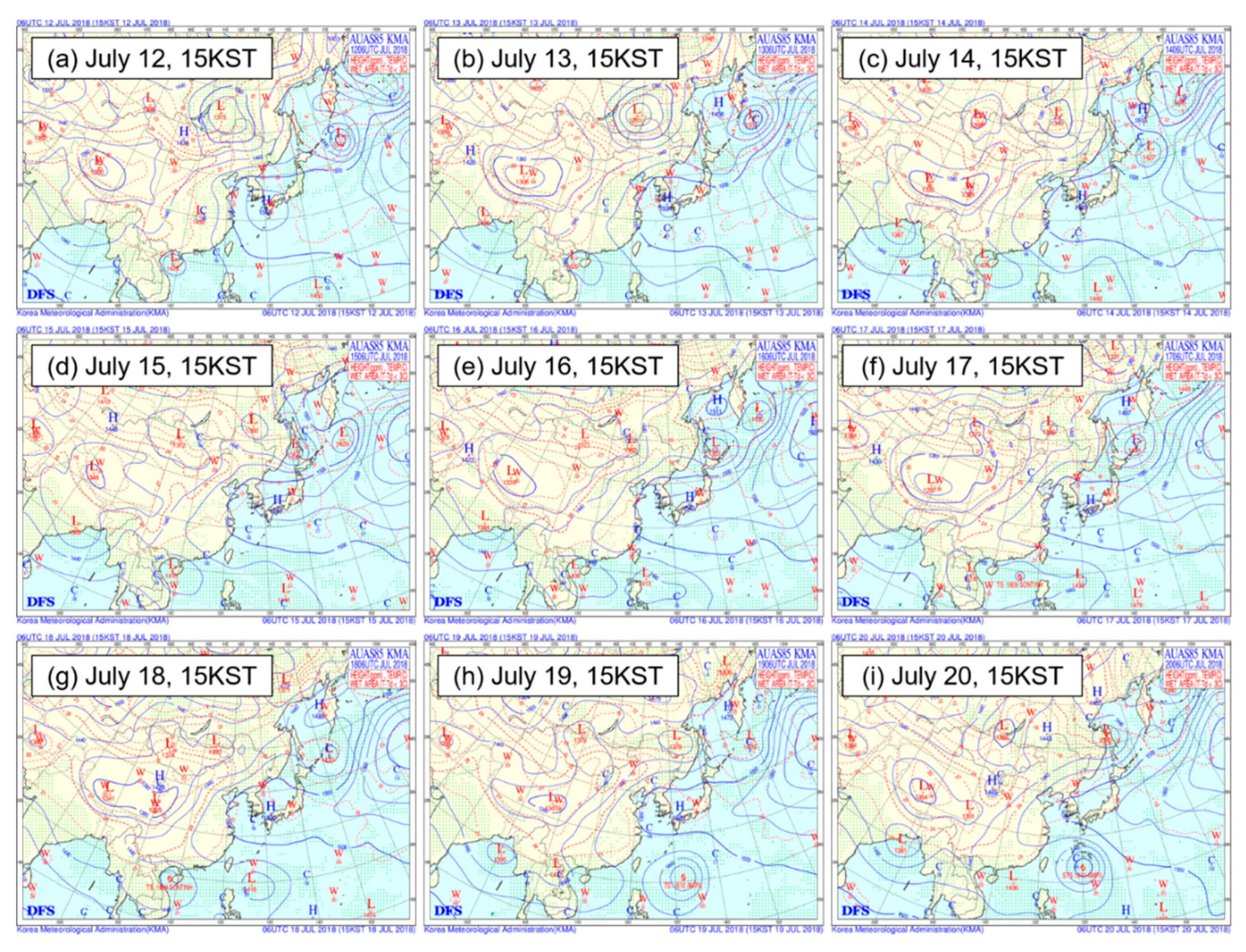
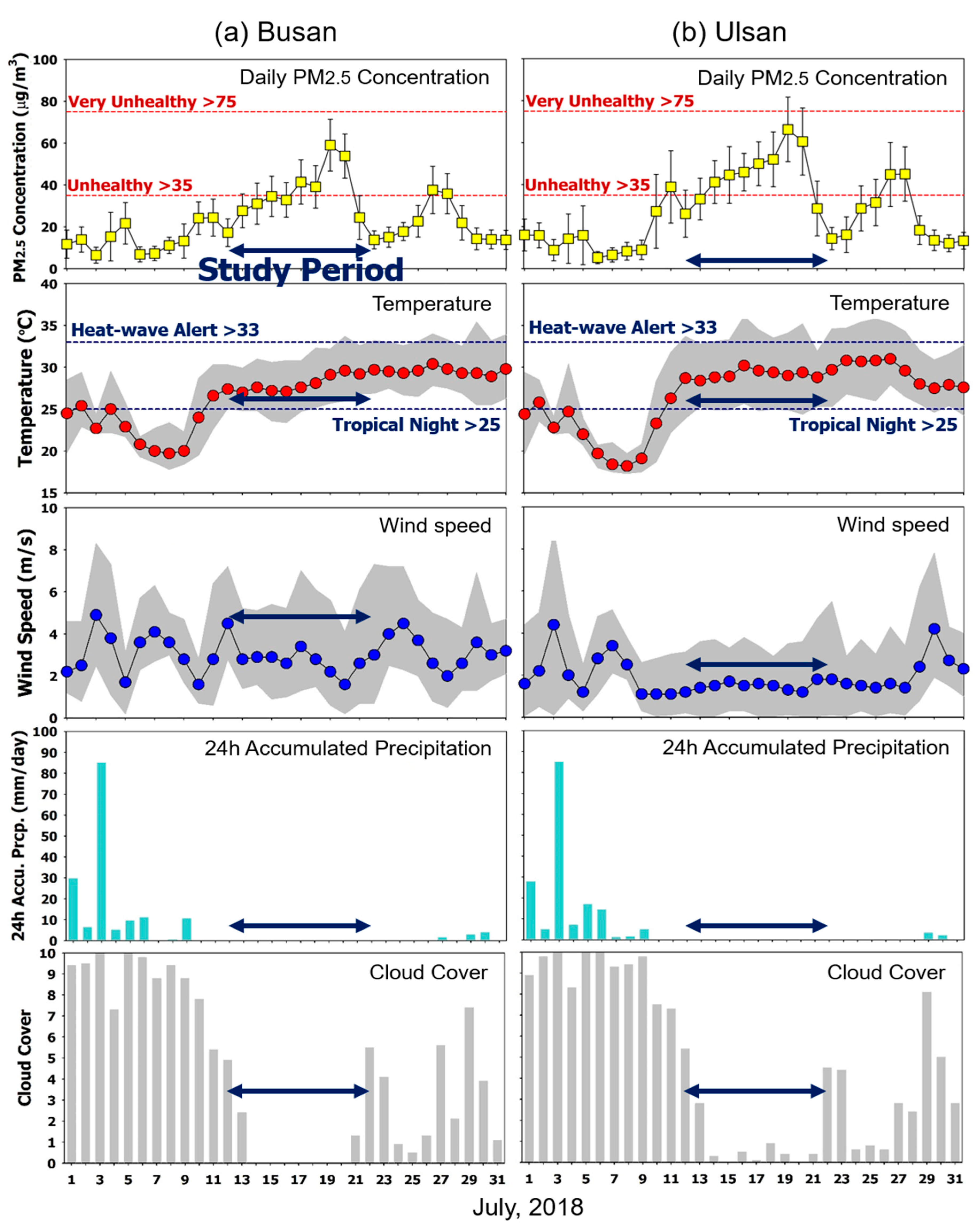

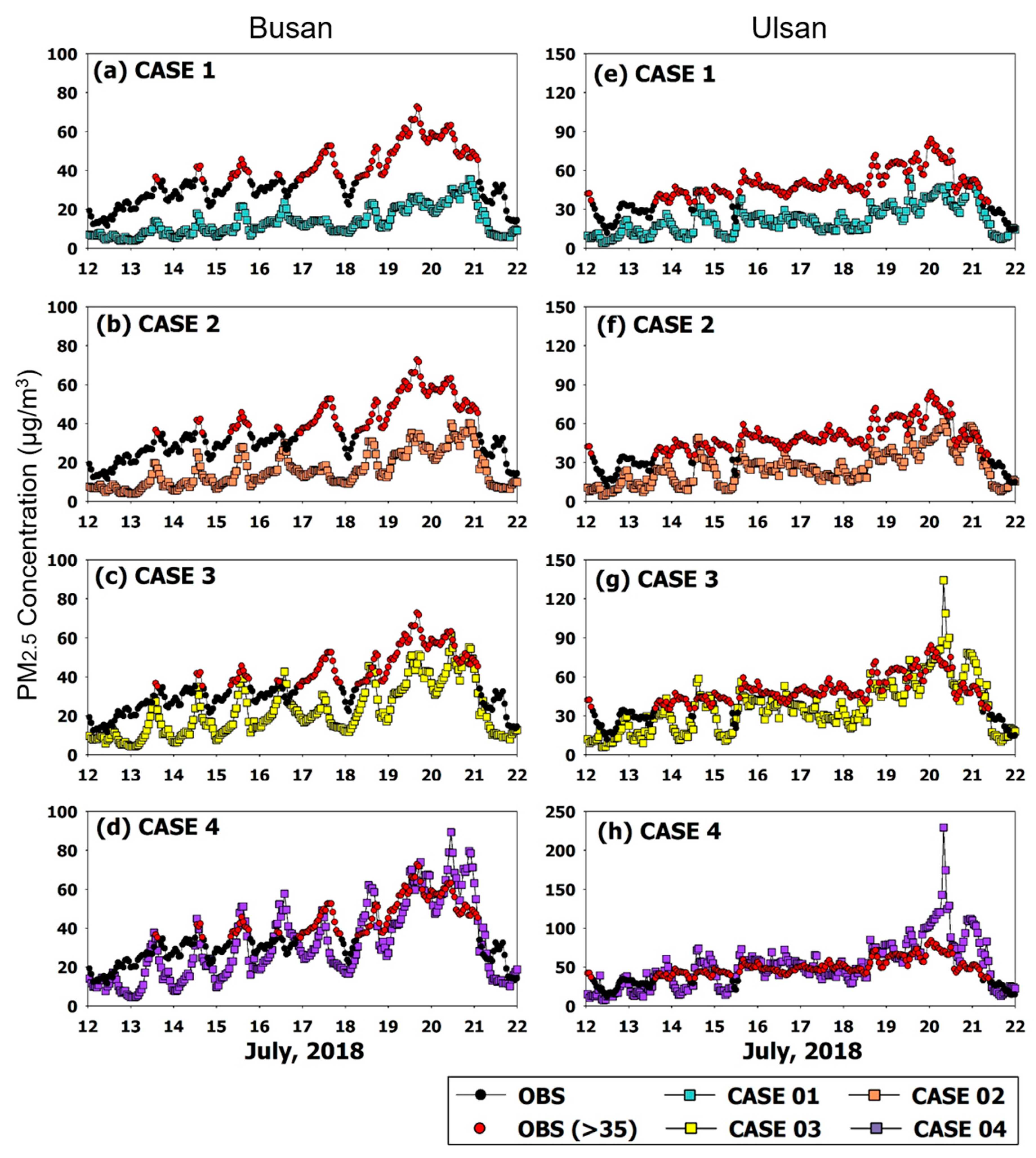
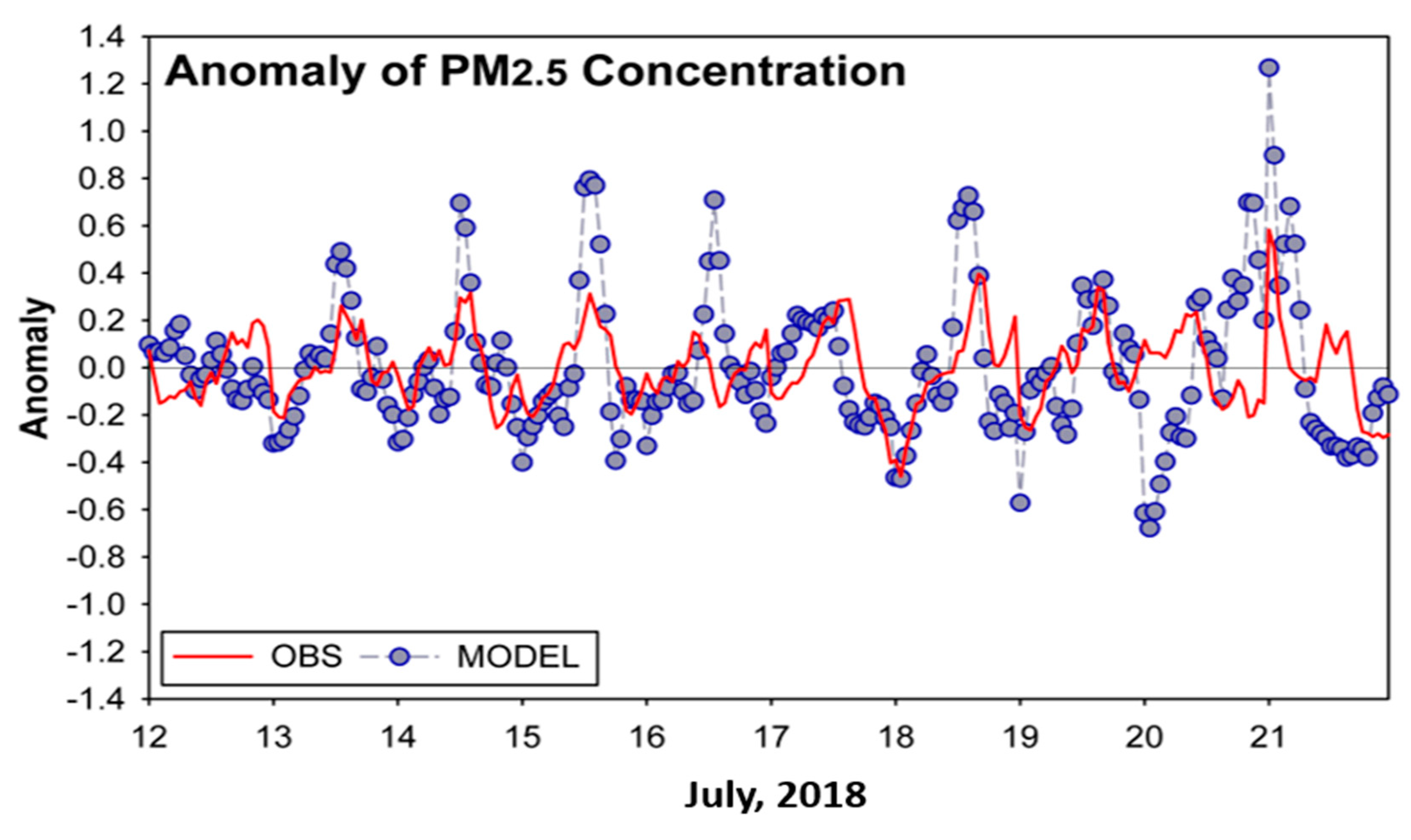
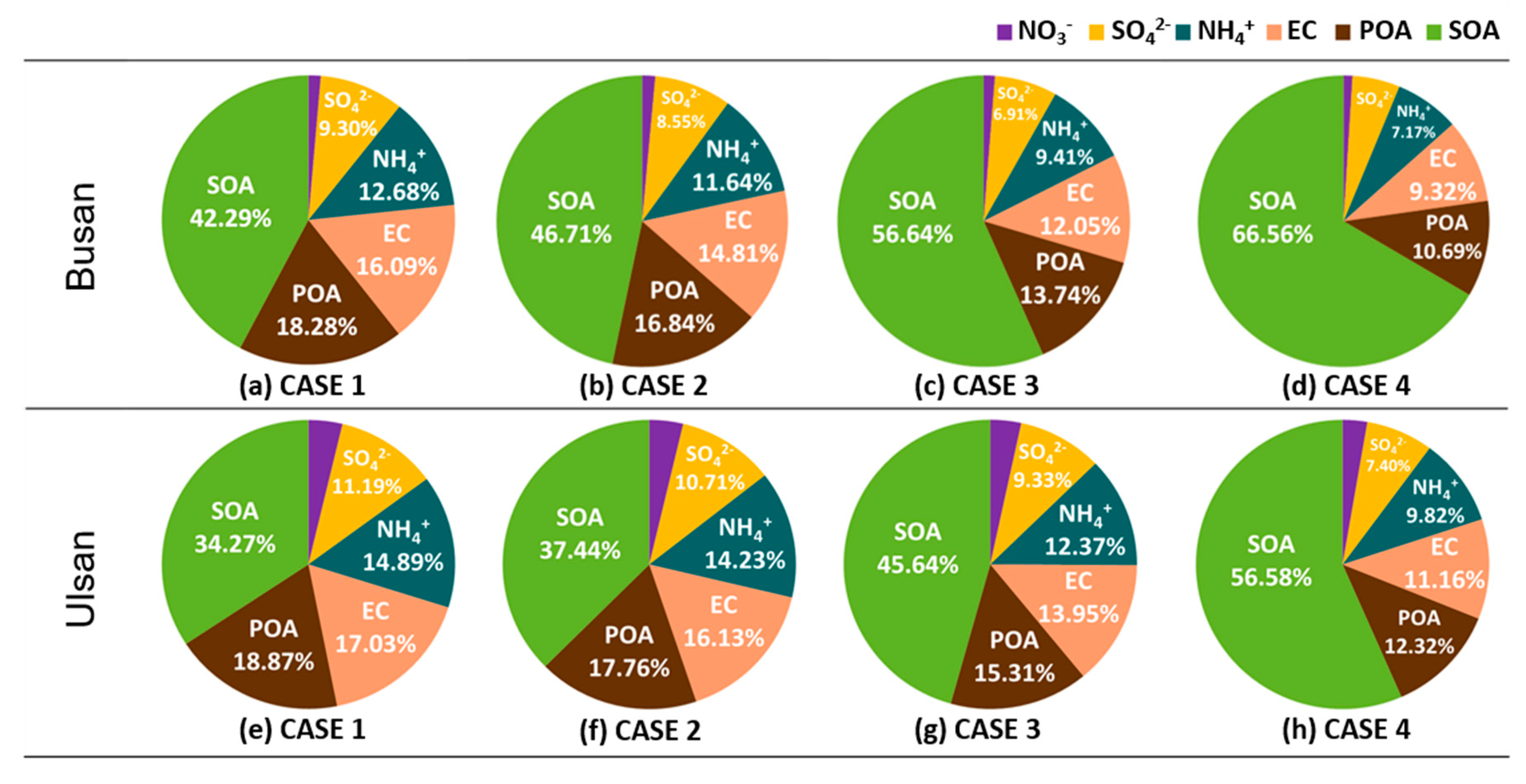

| WRF-Chem Version Horizontal Resolution Vertical Layer | 3.8.1 27km, 9km, 3km 31 |
| IC/BC Condition | NCEP FNL Reanalysis data |
| Observation Nudging | No |
| Microphysics | Lin et al. scheme |
| Longwave Radiation | Rapid Radiative Transfer Mode (RRTM) scheme |
| Shortwave Radiation | Goddard shortwave scheme |
| Cumulus Parameterization | Grell 3D Ensemble scheme |
| PBL | YSU scheme |
| Chemical Mechanism | NOAA/ESRL RACM Chemistry and MADE/VBS aerosols using KPP library |
| City | Category | 2015 | 2016 | 2017 | 2018 | |
|---|---|---|---|---|---|---|
| Busan | The number of rainy days in July | 14 days | 13 days | 15 days | 10 days | |
| Total precipitation amounts in July | 176.7mm | 188.8mm | 172.1mm | 122.1mm | ||
| PM2.5 (µg/m3) | June | 29.68 ± 16.93 | 27.19 ± 12.95 | 26.53 ± 16.55 | 25.54 ± 15.19 | |
| July | 20.99 ± 15.59 | 17.32 ± 9.93 | 23.76 ± 13.41 | 23.38 ± 15.35 | ||
| August | 23.23 ± 15.09 | 20.83 ± 13.16 | 16.15 ± 8.04 | 14.49 ± 7.16 | ||
| 1-h max | 74.77 (09KST, 15 July) | 68.13 (20KST, 27 June) | 58.59 (10KST, 29 June) | 72.76 (15KST, 19 July) | ||
| 24-h max | 62.28 (14 July) | 55.57 (27 June) | 50.00 (29 June) | 59.05 (19 July) | ||
| The number of days exceeding 35 µg/m3 | 16 days | 11 days | 10 days | 13 days | ||
| Ulsan | The number of rainy days in July | 16 days | 14 days | 19 days | 11 days | |
| Total precipitation amounts in July | 176.3mm | 226.9mm | 104.6mm | 160.3mm | ||
| PM2.5 (µg/m3) | June | 30.04 ± 17.36 | 25.03 ± 13.14 | 28.31 ± 16.19 | 28.50 ± 19.11 | |
| July | 22.25 ± 18.07 | 18.57 ± 11.34 | 27.33 ± 15.82 | 27.31 ± 19.91 | ||
| August | 23.51 ± 15.19 | 16.00 ± 12.28 | 15.98 ± 9.03 | 14.66 ± 8.34 | ||
| 1-h max | 83.17 (23KST, 14 July) | 62.50 (21KST, 27 June) | 66.20 (16KST, 12 July) | 84.15 (00KST, 20 July) | ||
| 24-h max | 71.73 (14 July) | 44.16 (20 June) | 54.72 (29 June) | 66.28 (19 July) | ||
| The number of days exceeding 35 µg/m3 | 22 days | 7 days | 19 days | 21 days | ||
| Area | Statistical Parameters | Obs. | CASE 1 | CASE 2 | CASE 3 | CASE 4 |
|---|---|---|---|---|---|---|
| Busan | Range | 11.56–72.76 | 3.87–35.50 | 3.89–40.12 | 4.04–61.15 | 4.41–89.23 |
| Mean | 36.15 | 13.36 | 15.89 | 22.38 | 31.65 | |
| Median | 33.89 | 11.52 | 13.64 | 18.63 | 26.18 | |
| Stand. Dev. | 13.53 | 7.17 | 9.01 | 13.46 | 19.67 | |
| Corr. Coeff. | 0.79 | 0.80 | 0.82 | 0.83 | ||
| IOA | 0.51 | 0.56 | 0.72 | 0.86 | ||
| RMSE | 24.53 | 21.93 | 16.05 | 12.29 | ||
| NMB | −63.04 | −56.03 | −38.09 | −12.43 | ||
| MBE | −22.79 | −20.25 | −13.77 | −4.49 | ||
| Ulsan | Range | 11.77–84.15 | 3.76–53.80 | 4.16–65.69 | 5.74–134.21 | 6.97–229.24 |
| Mean | 44.92 | 21.82 | 26.04 | 36.50 | 51.61 | |
| Median | 45.65 | 20.19 | 22.99 | 34.42 | 48.26 | |
| Stand. Dev. | 14.61 | 11.45 | 13.79 | 20.55 | 31.29 | |
| Corr. Coeff. | 0.71 | 0.73 | 0.75 | 0.74 | ||
| IOA | 0.53 | 0.62 | 0.78 | 0.74 | ||
| RMSE | 25.36 | 21.60 | 16.12 | 23.75 | ||
| NMB | −51.41 | −42.03 | −18.75 | 14.90 | ||
| MBE | −23.09 | −18.88 | −8.42 | 6.69 |
© 2020 by the authors. Licensee MDPI, Basel, Switzerland. This article is an open access article distributed under the terms and conditions of the Creative Commons Attribution (CC BY) license (http://creativecommons.org/licenses/by/4.0/).
Share and Cite
Yang, G.-H.; Jo, Y.-J.; Lee, H.-J.; Song, C.-K.; Kim, C.-H. Numerical Sensitivity Tests of Volatile Organic Compounds Emission to PM2.5 Formation during Heat Wave Period in 2018 in Two Southeast Korean Cities. Atmosphere 2020, 11, 331. https://doi.org/10.3390/atmos11040331
Yang G-H, Jo Y-J, Lee H-J, Song C-K, Kim C-H. Numerical Sensitivity Tests of Volatile Organic Compounds Emission to PM2.5 Formation during Heat Wave Period in 2018 in Two Southeast Korean Cities. Atmosphere. 2020; 11(4):331. https://doi.org/10.3390/atmos11040331
Chicago/Turabian StyleYang, Geum-Hee, Yu-Jin Jo, Hyo-Jung Lee, Chang-Keun Song, and Cheol-Hee Kim. 2020. "Numerical Sensitivity Tests of Volatile Organic Compounds Emission to PM2.5 Formation during Heat Wave Period in 2018 in Two Southeast Korean Cities" Atmosphere 11, no. 4: 331. https://doi.org/10.3390/atmos11040331
APA StyleYang, G.-H., Jo, Y.-J., Lee, H.-J., Song, C.-K., & Kim, C.-H. (2020). Numerical Sensitivity Tests of Volatile Organic Compounds Emission to PM2.5 Formation during Heat Wave Period in 2018 in Two Southeast Korean Cities. Atmosphere, 11(4), 331. https://doi.org/10.3390/atmos11040331






